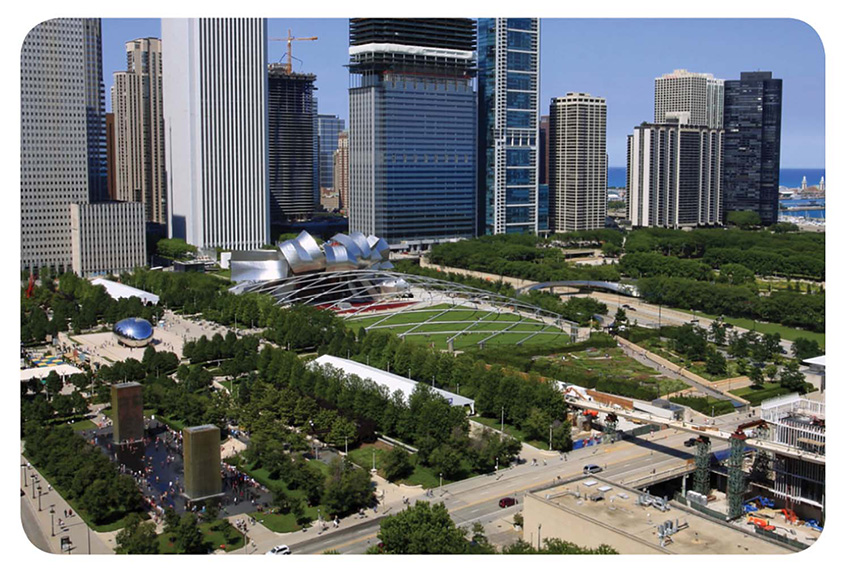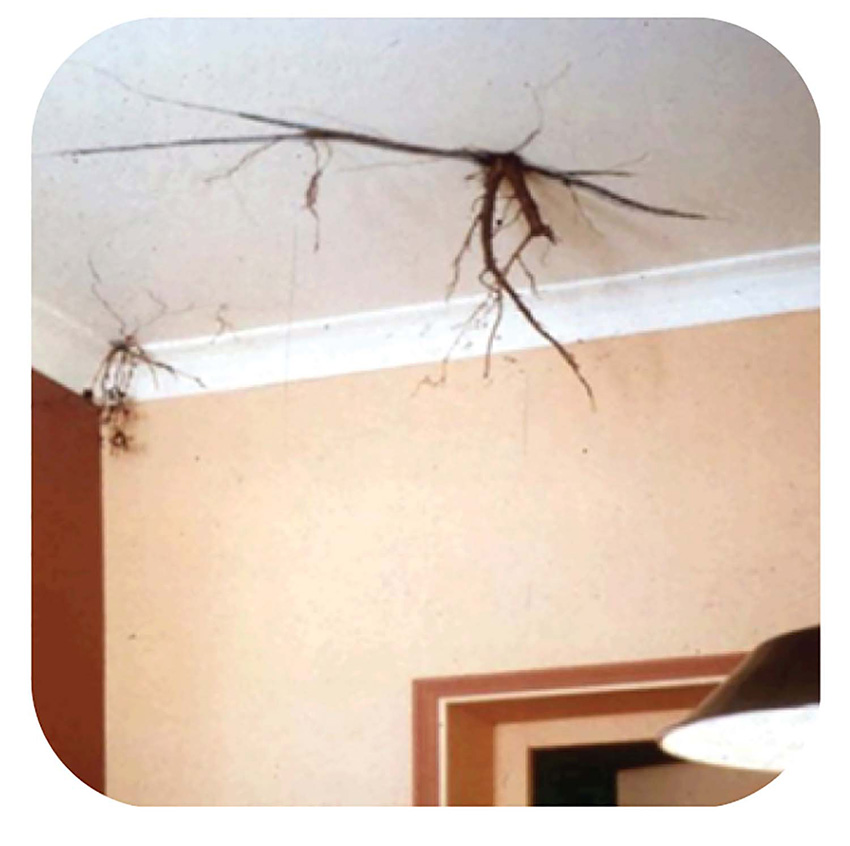Vegetated Roof Systems
Types of Vegetated Roofs
Green roofs are often chosen based on their soil depth and structural requirements, intended purpose and maintenance needs. There are three main types of green roofs that differ by cost, depth of growing medium and plant types.
Extensive systems, also known as compliance roofs, are considered the “work horses” of vegetated roofs. They provide a lightweight, low-maintenance green roof solution and as such, are the most specified and least expensive of all green roof options. Typically, this type of vegetated roof is selected for large, flat-roofed buildings and is a good option for low-sloped roofs and retrofit styles. Installation methods can vary, but extensive roofs can often be installed in a very short period of time to provide an instant green effect.
Extensive green roof systems are the shallowest type of system at 3 to 6 inches in depth and can weigh up to 42 pounds-per-square-foot when saturated. This type of vegetated roof is not usually intended for general public access, rather, they are chosen mostly for their ecological benefits. Types of vegetation used on these roofs include sedums and certain drought tolerant perennials and grasses. Typically, they do not require irrigation in most climates, except in the south and southwest, and in high desert areas.

Two examples of extensive vegetated roof systems.
Semi-intensive Systems
Semi-intensive systems are a combination of both extensive and intensive types, providing a “best of both worlds” solution. This type of system opens up the plant palette tremendously. They include a richer, deeper substrate and drainage solution compared to extensive roofs, which enable the use of a wider range of plant mixtures. Perennials, taller grasses and even some small shrubs, can all be specified. This type of roof can also store and/or detain a lot of rainwater. Unlike an extensive system, it is quite common to see an irrigation system with a semi-intensive green roof.
These systems are 6 to 10 inches in depth and many times defined up to 12 inches in depth. When they are saturated, semi-intensive systems can weigh up to 84 pounds-per-square-foot. With deeper growing depths and the expanded plant palette, these systems offer much more design flexibility than extensive vegetated roofing.

Three examples of semi-intensive vegetated roof systems.
Intensive Systems
Intensive systems are designed to replicate what is typically found at ground level in the natural landscape, as well as in green spaces like parks or cultivated gardens. You are likely to see intensive systems used on commercial buildings where owners want to have large green areas that incorporate all sizes and types of plants. They are made for those who have the time and the mindset to put in fully landscaped rooftop gardens, as well as those who do not mind the regular maintenance that it requires.
Intensive systems can include perennials, groundcovers, shrubs, trees and even turf grass, along with the proper irrigation system. Tables, benches, planter boxes, ponds, fountains and greenhouses can be installed on an intensive green roof to offer places for people to relax, dine or work in a picturesque park-like setting. As far as the irrigation and drainage systems are concerned, they must operate at peak efficiency to reduce the chance of overloading the roof’s structure.

Example of an intensive vegetated roof system. Notice the landscape structure on top of Millennium Park in Chicago. Below is all occupied space.
Vegetated Roof Components
Just as the strength of any building is largely dependent on the building’s foundation, the success of a green roof depends greatly on its compatibility with the roof structure it is built on. Green roofs consist of many components that promote vegetation growth. When constructing a green roof, special attention must be paid to the materials and design in order to ensure that the integrity of the roof’s structure is not compromised. The construction of this type of roof typically includes layers of drainage material and planting media on a high-quality waterproof membrane, along with other components.
Waterproofing Membranes—waterproofing membranes are the most important component of the vegetated roof. Not only must waterproofing membranes prevent water from entering the building from the outside, but they must also be capable of resisting mechanical damage from tools and the penetration of plant roots. In addition, these materials should be capable of lasting many years without repair or replacement, as the roof garden will need to be deconstructed to perform any repairs.
Waterproofing membranes are available in options including SBS-modified bitumen, hot rubberized asphalt, polymethyl methacrylate (PMMA) liquid membrane and polyvinylchloride (PVC). Waterproofing membrane systems can be installed in a standard configuration over insulation and recovery board, or in an inverted roof membrane assembly (IRMA), known as protected membrane roofs (PMR).
Both types of assemblies have pros and cons. PMRs are protected, but are harder to repair or troubleshoot when there is a leak because the membrane is buried. IRMA green roofs contain many of the components explored in this unit, including root barriers, XPS insulation, a drainage layer, growing medium and plants. Conventional assemblies provide easier access to the membrane, but are potentially more susceptible to physical damage.
Root barrier—simply put, root barriers protect the waterproofing membrane from root penetration. The FLL has established a standardized method for investigating and determining the root penetration resistance of waterproofing products used throughout Europe. Root barriers are used to create a physical boundary between plant roots and the waterproofing membrane.
SBS-modified bitumen, hot rubber and PMMA require root barriers. Typical root barriers are made from LLDPE (linear low density polyethylene). Seams are either heat welded or taped with polyethylene or butyl seam tape. Thicknesses range from 20 mils to 40 mils depending on the vegetated roof plant types. Root barriers can also be made from PVC or ethylene propylene diene terpolymer (EPDM).

Root barriers are needed to avoid situations like shown in this picture where roots have penetrated the roof of the structure.
Insulation—insulation for PMR assemblies is made from extruded polystyrene (XPS). Generally, insulation layers are 1 to 4 inches in thickness and are installed directly over the root barrier. Insulation typically includes drainage grooves and channels or installers can insert a synthetic drainage in lieu of drainage channels.
Drainage layers—drainage mats combine drainage and protection functions for the green roof and are available in four types—dimpled drain, entangled net, drainage plate and lightweight aggregate. The first three are lighter in weight compared to the lightweight aggregate and are synthetic (typically polyethylene or polypropylene).
Capillary mat or moisture retention mat—sometimes extra water-hold capacity is needed and many drainage layers will have an optional integrated capillary or moisture retention mat for this reason. Capillary mats are used in green roof construction to help distribute water evenly throughout the roof system. The moisture retention layer can also be a separate component.
Edge restraints and drain access boxes—edge restraints and drainage access boxes provide a physical separation between the vegetated roof and the vegetation free zones or drains. Most are made from aluminum, stainless steel or high impact resistant plastic.
Growing medium—the soil media provides a structure to which roots can attach, retains moisture after rainfall, provides minerals and nutrients, and allows for gas exchange. When it comes to soil used on a vegetated roof, there are many variables to consider. The right depth for the growing medium will be determined by site conditions, such as local precipitation patterns, and sun and wind exposure. The type of vegetated roof chosen can also impact the kind of growing medium needed. For example, the extensive vegetated roof generally has the largest aggregate sizes and uses the least amount of organics.
Soil considerations—in addition to soil varying by the type of vegetated roof chosen, it can also vary based on the plant selection. When selecting soil, special consideration should also be given to the soil’s ability to retain volume, drain adequately and supply nutrients. Also consider that the soil must use a filter fabric and not contain any silt that could potentially clog the fabric.
Soil content—engineered soil ratios and mix designs utilize both mineral and organic soils and vary by region and supplier. A typical mix of soil contains lightweight aggregate, organics and graded sand.
Minimum soil depths—depending on the type of vegetation chosen, soil depths will vary. Generally speaking, sedums will require 3 to 4 inches of soil, grasses need 6 to 10 inches, and shrubs and trees generally require 12 inches or more of soil.
Growing medium delivery methods—soil can be delivered to the vegetated roof in a number of ways, including blown in place, delivery by totes or delivery by cubic yard bags. Blown-in-place growing medium delivery eliminates the need for equipment such as cranes, man lifts and wheelbarrows, and allow for quick installation. Bags or totes can be palletized and wrapped to be brought to the location.
Vegetation—given adequate growing medium depth and irrigation, just about any plant can be grown on a green roof. It is really up to the building owner to determine the aesthetic they are looking for when choosing vegetation. Whether choosing sedums, grasses, annuals, perennials, shrubs or trees, or any combination of those, the possibilities are endless.
Vegetated mats and tiles—vegetated mats and tiles can provide an instant vegetated roof. The mats and tiles come in either coconut coir or nylon entanglements, and sedums are typically used as the plantings. Mats and tiles are rolled out or placed onto the growing media, creating an instant green roof.
Modular systems—modular systems are good for extensive systems, especially on logistically challenging projects. However, they can be expensive. These systems can be made of recycled or virgin high-density polyethylene (HDPE) or polypropylene (PP). Tray systems can be pre-planted with typical sedum plantings, and all trays feature a drainage component, growing medium and plant components. Since the plants are already established, there can be fewer issues with replacement plants that do not take root or thrive. However, in most modular systems moisture cannot flow between modules, increasing the impacts of wet and dry spells on the plants.









